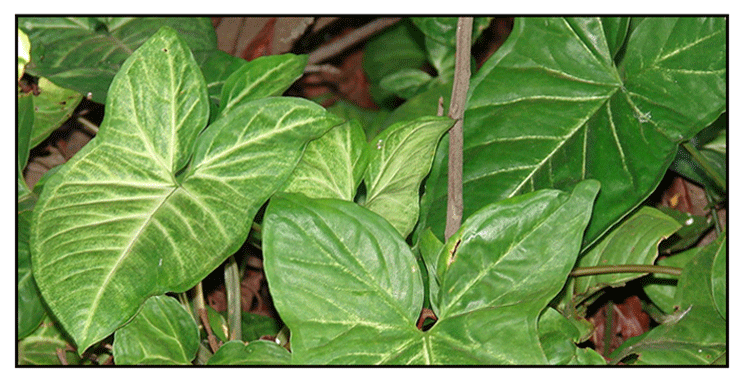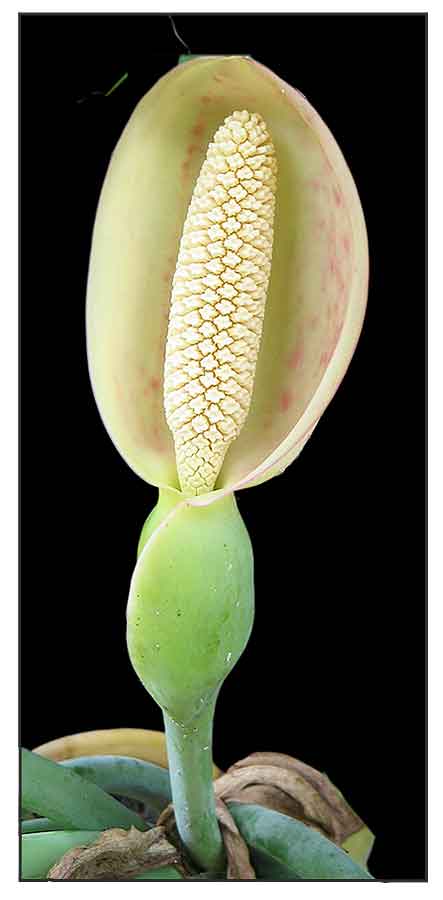 Gen info Gen info
- Syngonium is a genus of about 36 species of flowering plants in the Araceae family.
- Syngonium podophyllum is the most commonly cultivated species in the genus Syngonium. It is often referred to simply as syngonium.
- The specific epithet podophyllum derives from Latin, meaning "with foot/feet-like leaves". (24)
Botany
• Syngonium podophyllum is a perennial vine growing to a height of 10-20 meters. Petioles are slender. Leaves are arrow-shaped, thin, green and undulating. Leaves change shape as they mature, becoming bigger and lobed.
• It climbs a few meters tall over the trunks of tropical jungle trees, clinging by its roots. The cultivars cultivated indoors reach a height of up to 1.5 m (4.9 ft). During the year, the plant grows about 30 cm (12 in) and produces 6-7 leaves. Its single leaves, usually arrow-shaped, are up to 30 cm (12 in) long. In the wild, the leaves are dark green and without variegation. Cultivated varieties  have leaves in various shades of green, often light green and usually with different types of lighter tannins. There are several variegated cultivars, the main differences being in the position and extent of the cream or white markings. Some leaves are almost entirely white, pink or yellow. Flowers are small, greenish or whitish on spadices within light-yellow through green spathes. However, the plants grown indoors do not bloom, aside from the older, well-cared-for specimens. (24)
 Distribution Distribution
- Recently introduced to the Philippines.
- Native to Mexico and Costa Rica.
- In Florida, USA, considered a destructive invader. (19)
Constituents
- Analysis of volatile oil by GC/MS yielded forty-three compounds. Main compounds were alpha-ionone, geranyl acetone, ß-ionone, dithdroactinidiolide, hexadecanoic acid, phytol, and linoleic acid, among others, together with carbonyl chemicals, fatty acid, and hydrocarbon. (8)
- Phytochemical screening of leaves yielded alkaloids and saponins. (11)
- Phytochemical screening of acetate extract of dried leaf samples yielded the presence of flavonoids, terpenoids, reducing sugars, alkaloids, and saponins. Total phenolic and flavonoid contents were 3.67 ± 0.02 mg propyl galate equivalent and 3.23 ± 0.02 mg quercetin equivalents per gram of sample. (see study below) (12)
- Phytochemical analysis of methanol extract and fractions of leaves yielded alkaloids, tannins, resins, flavonoids, and steroids. (see study below) (17)
Properties
- Arrowhead vine is a strong climber, easily reaching the tops of trees, potentially making trees top-heavy and more susceptible to toppling in a strong wind. (19)
-
Studies suggest antibacterial, antifungal,antioxidant,analgesic, anti-inflammatory, cytotoxic, anticancer, air-purifying, antihypertensive properties.
Parts
utilized
Bark, roots, leaves.
Uses
Folkloric
• No reported folkloric medicinal use in the Philippines.
• In Belize, roots and bark used in traditional medicine for treatment of superficial and deep wounds.
• In Central American, used for various skin disorders.
• In Suriname, sap is swabbed into the cavity of an aching tooth to relieve pain. Decoction of crush leaves use as wash to treat stomachache. (13)
• In Bangladesh, whole plant considered tonic; used for dermatitis. (14)
Others
• Indoor Plant / Air Purifier: One of the plants studied and found effective in helping to remove indoor air pollutants such as benzene, formaldehyde, xylene, and toluene. (see toxicity concerns below)
• Groundcover: Can be used as a groundcover plant.
Studies
• Antibacterial:
A study was done on 21 extracts of seven plants used in wound healing, including Syngonium podophyllum leaves and bark, to evaluate antibacterial properties against strains of E coli, P aeruginosa, S aureus and E faecalis. Almost all the extracts showed some growth inhibition of one or more bacterial strains. Antibacterial activity was reported for the first time for Syngonium podophyllum. Â (1)
• Anti-Inflammatory:
Extracts of seven herbal drugs used in Central American folk medicined were evaluated for their topical anti-inflammatory activity against Croton oil-induced ear edema in mice. All the extracts, including S podophyllum induced dose-dependent edema reduction, presenting potential sources of principles with high anti-inflammatory activity. (4)
• Antibacterial / Antioxidant / Cytotoxicity / Hepatotoxic / Leaves:
Study evaluated the in vitro antioxidant, antibacterial, and cytotoxic potential of Syngonium podophyllum and Eichhornia crassipes leaf aqueous extracts and their in vivo effect of oxidative stress and hepatic biomarkers in isoniazid induced rats. Both extracts showed considerable antibacterial activity against Proteus vulgaris, Salmonella typhi, and Bordetella bronchiseptica. SP showed 51% cytotoxicity against lung cancer (NCI-H322) cell line. SP showed a phenolic content of 5.36 ± 0.32 PGE/g. Both showed 13%-65% protection against lipid peroxidation in rat tissue. However the S. podophyllum extract was found to be hepatotoxic. (6)
• Cytotoxicity / Leaves:
Study evaluated the cytotoxic potential and phytochemical screening of S. podophyllum leaves and X. safittifolium rhizomes. Among all extracts, Syngonium podophyllum leaves showed the highest cytotoxic potential with LD50 value of 16.67 µg/ml. (7)
• Isoschaftoside / Potential Antihypertensive:
Study investigated the in vitro effects of isoschaftoside isolated from Syngonium podophyllum on pig kidney Na+, K+, ATpase. Isoschaftoside significantly decreased renal Na+K+ATpase. Results suggest a promising compound for the treatment of hypertension. (9)
•
Antioxidant / Antimicrobial / Anticancer / Leaves: Study of ethyl acetate leaf extract reducing ability in the range of 0.170-0.350. Extract showed moderate DPPH radical scavenging potential (50%) and metal ion chelating ability (55%) at higher concentrations. Extract showed 43% growth inhibition against lung cancer (NCI-H322) and 53% against breast cancer (T4D) lines. It showed considerable antibacterial activity by disc diffusion assay against Bacillus cereus, Streptococcus mutans, Proteus vulgaris, Salmonella typhi, and Brodetella bronchiseptica. (12)
• Analgesic / Anti-Inflammatory
/ Leaves: Study evaluated the analgesic and anti-inflammatory activities of methanol extract and various fractions of Syngonium podophyllum leaves. A methanol extract showed significantly higher (60.53%, p<0.001) analgesic activity in tail immersion test and marked inhibition (59.58%, p<0.01) of analgesic in acetic acid induced writhing test. The ME extract also showed significant (71.11%, p<0.001) anti-inflammatory effect in carrageenan induced paw edema test. The analgesic and anti-inflammatory effects suggest a potential source of natural agents for treatment of diseases related to analgesia and inflammation. (15)
• Antibacterial / Antifungal: Study evaluated the antibacterial and antifungal activities of methanol extracts of Melaleuca decora aerial parts and Syngonium podophyllum whole plant against various bacterial and fungi. Both plants exhibited potent antibacterial and antifungal activities. S podophyllum showed considerable activity against S. aureus with low activity for B. cereus and P. mirabilis. Both plants showed antifungal activity only against S. cerevisae. (16)
• Phytochemicals / Antioxidant / Leaves: Study evaluated the phytochemical constituents and antioxidant activities of various extracts and fractions of S. podophyllum leaves. Phytochemical analysis yielded alkaloids, tannins, resins, flavonoids and steroids. The methanol extract yielded the highest amount of TPC (10.55 mg of GAE/g of dried extract. The ME also showed highest radical scavenging activity (79.89%) by DPPH assay. Results suggest a promising source of natural antioxidants. (17)
• Positive Effect
of Sawdust Vermicompost on Growth and Nutrition: Study evaluated the effects of four concentrations (9, 250, 500, and 1000 ppm) of sawdust vermicompost extract on growth and nutrition of S. podophyllum. Spraying on Syngonium plants resulted in significant growth. Pot plants treated with1000 ppm vermicompost extract exhibited higher height, leaf area, chlorophyll, shoot fresh weight, and shoot dry weight than control plants. Results suggest the sawdust vermicompost has positive effects on plant growth. (18)
• Green Synthesis / Silver Nanoparticles / Anticandidal Activity / Leaves: Study
reports on the simple and economical synthesis of silver nanoparticles from leaf extract of S. podophyllum. The leaf extract showed strong antifungal activity against C. albicans. Results suggest potential application in medical and pharmaceutical fields for formulation of new drugs. (20)
• Silver Nanoparticles / Antibacterial Activity / Leaves: Study
reports on the green synthesis of silver nanoparticles using an aqueous solution of dry leaves of Syngonium podophyllum as reducing, capping, and stabilizing agent. Using well diffusion method the AgNPs were evaluated for antibacterial activity against four bacteria viz., E. coli, P. aeruginosa, B. subtilis, and S. aureus. (23)
Toxicity / Concerns
• All parts of the plant are considered poisonous and causes severe mouth pain if eaten.
• Araceae contain calcium oxalate crystals, believed to cause intense local irritation on handling or consuming. Some attribute the reaction to other compounds present as the irritation is not seen in properly cooked plants, although the crystal persist after heating.
• Leaves are constantly shedding, and while the plant seem out of reach, fallen leaves may be nearby.
• Considered air-purifying, with health benefits, to boot, it is not an ideal plant in houses with children and pets.
• Poisoning in cats: The plant is highly toxic to felines. Signs of poisoning include dry heaving, vomiting, gagging, pawing at the mouth, excessive drooling, head shaking. The cat may also vocalize as the sap from the plant causes needle-like pain to the tongue, mouth, and throat. There is no known antidote. Prognosis is poor, but may be improved with veterinary attention. (22)
Availability
- Wild-crafted.
- Seeds in the cybermarket.
|

![]()

